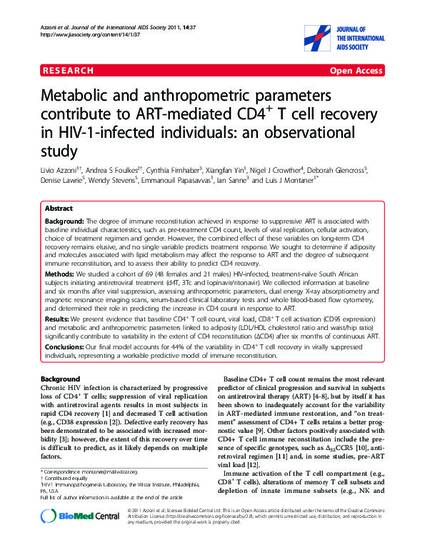
Background The degree of immune reconstitution achieved in response to suppressive ART is associated with baseline individual characteristics, such as pre-treatment CD4 count, levels of viral replication, cellular activation, choice of treatment regimen and gender. However, the combined effect of these variables on long-term CD4 recovery remains elusive, and no single variable predicts treatment response. We sought to determine if adiposity and molecules associated with lipid metabolism may affect the response to ART and the degree of subsequent immune reconstitution, and to assess their ability to predict CD4 recovery. Methods We studied a cohort of 69 (48 females and 21 males) HIV-infected, treatment-naïve South African subjects initiating antiretroviral treatment (d4T, 3Tc and lopinavir/ritonavir). We collected information at baseline and six months after viral suppression, assessing anthropometric parameters, dual energy X-ray absorptiometry and magnetic resonance imaging scans, serum-based clinical laboratory tests and whole blood-based flow cytometry, and determined their role in predicting the increase in CD4 count in response to ART. Results We present evidence that baseline CD4+ T cell count, viral load, CD8+ T cell activation (CD95 expression) and metabolic and anthropometric parameters linked to adiposity (LDL/HDL cholesterol ratio and waist/hip ratio) significantly contribute to variability in the extent of CD4 reconstitution (ΔCD4) after six months of continuous ART. Conclusions Our final model accounts for 44% of the variability in CD4+ T cell recovery in virally suppressed individuals, representing a workable predictive model of immune reconstitution.
Available at: http://works.bepress.com/andrea_foulkes/9/

This work is licensed under a Creative Commons Attribution 3.0 Unported License.